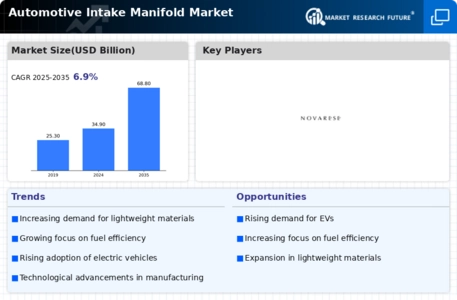Top Industry Leaders in the Automotive Intake Manifold Market
 The automotive intake manifold market is a lively and ever-evolving sector, with a mix of established giants and emerging players striving to secure their share of the market. To gain a comprehensive understanding of this competitive arena, it is imperative to scrutinize key players, their strategic approaches, factors influencing market share, and the emerging trends that shape the market.
The automotive intake manifold market is a lively and ever-evolving sector, with a mix of established giants and emerging players striving to secure their share of the market. To gain a comprehensive understanding of this competitive arena, it is imperative to scrutinize key players, their strategic approaches, factors influencing market share, and the emerging trends that shape the market.
Key Players and Their Strategies: Prominent players in the automotive intake manifold market include Edelbrock L.L.C., Magnetic Marellic S.p.A., Rochling Group, Holley Performance Products, Sogefi SpA, Keihin North America, Inc., Aisin Seiki Co., Ltd, MAHLE GmbH, Donaldson Company, Novares, Mikuni Corporation, and others.
-
Tier 1 Automotive Suppliers: Major players like Bosch, Continental AG, Delphi Technologies, and Mahle GmbH dominate the market, utilizing their vast experience, global presence, and strong ties with automakers. These industry leaders focus on product innovation, developing advanced intake manifolds featuring variable intake runner systems and lightweight materials to enhance engine performance and fuel efficiency. Additionally, they emphasize cost optimization and operational efficiency to sustain their competitive edge.
-
Emerging Players: New entrants such as Yapp Automotive and Shanghai Jinda Automotive Systems Co., Ltd. are actively disrupting the market with innovative designs, cost-effective solutions, and adaptability to changing market dynamics. These companies often concentrate on specific niches or emerging markets, catering to the rising demand for lightweight and eco-friendly materials.
-
Collaboration and Partnerships: The landscape of the intake manifold market is witnessing an upsurge in strategic partnerships and collaborations. Established players are joining forces with startups and research institutions to gain access to cutting-edge technology, hastening the pace of innovation. This collaborative approach enables companies to stay ahead of the curve and respond effectively to evolving customer needs.
Factors for Market Share Analysis: Several critical factors influence the market share of companies in the automotive intake manifold market, including:
-
Product Portfolio Breadth and Depth: Companies offering a diverse range of products that cater to various engine types, vehicle segments, and performance requirements hold a significant advantage.
-
Technological Innovation: Industry leaders who pioneer the development and commercialization of advanced intake manifold technologies, incorporating features like variable intake runner systems and active noise cancellation, attract a larger customer base and command higher market share.
-
Manufacturing Efficiency and Cost Competitiveness: Companies with streamlined manufacturing processes and cost-effective production can offer competitive prices, attracting more customers while ensuring profitability.
-
Global Reach and Distribution Network: A robust global presence with strong distribution channels enables wider market penetration and increased sales volume, contributing to higher market share.
-
Brand Reputation and Customer Relationships: Well-established brands with a solid track record of quality, reliability, and customer service build trust and loyalty, leading to increased market share.
New and Emerging Trends: Several emerging trends are shaping the future of the automotive intake manifold market:
-
Lightweight Materials: The increasing demand for fuel-efficient vehicles propels the adoption of lightweight materials such as aluminum, magnesium, and composite materials in intake manifolds. This trend favors companies with expertise in material development and manufacturing processes for these materials.
-
Smart and Connected Manifolds: The integration of sensors and electronics into intake manifolds is paving the way for smart and connected manifolds. This allows for real-time monitoring and optimization of air intake, potentially improving engine performance and fuel efficiency. Companies investing in this technology are poised to gain an edge in the future.
-
3D Printing: Additive manufacturing technologies like 3D printing offer opportunities for customization and design optimization of intake manifolds. This allows for more complex designs with improved performance and lighter weight. Companies adopting this technology early can gain a competitive advantage.
To succeed in this competitive landscape, companies need to focus on continuous innovation, cost optimization, strategic partnerships, and adapting to emerging trends. Those demonstrating agility, technological leadership, and a strong customer focus will be best positioned to capture market share and thrive in this dynamic market.
Additional Considerations:
- The competitive landscape can vary significantly across different regions, with regional players holding strong positions in their respective markets.
- Government policies and incentives for fuel-efficient vehicles can influence market dynamics and growth trajectory.
- The increasing adoption of electric vehicles can pose a long-term challenge to the traditional automotive intake manifold market.
By comprehending these key factors and trends, companies can develop effective strategies to navigate the competitive landscape of the automotive intake manifold market and achieve sustainable growth.
Industry Developments and Latest Updates:
-
Edelbrock L.L.C.: Launched the Victor X intake manifold for GM LS engines, promising increased horsepower and torque. (Source: Edelbrock website, Oct 2023) -
Magnetic Marellic S.p.A.: Received a contract from a major European automaker to supply intake manifolds for its next-generation hybrid powertrains. (Source: Marellic press release, Oct 2023) -
Rochling Group: Acquired Polymer Extruded Products, a US-based manufacturer of plastic intake manifolds, expanding its market reach. (Source: Rochling press release, Aug 2023) -
Holley Performance Products: Collaborated with Edelbrock on intake manifold and carburetor packages for classic muscle cars. (Source: Holley website, Sept 2023)

